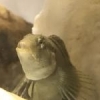Room temperature affects on temperate species
#1

Posted 27 August 2020 - 04:42 PM
#2

Posted 28 August 2020 - 09:38 AM
Matt, my oyster reef tank had several blennies (one female and 5 males), 6 naked gobies, and 5 skilletfish. I kept them at room temperature, where winter water temperatures in my basement were 58 degrees, and in the summer, 78 degrees. All three species bred when the water temperature was about 62 degrees, laying and guarding eggs all summer long. Your fish will do well with your water temps.
In the wild, all three species go deep seeking warmer water. In the winter, in deep water, those temperatures in the Chesapeake are about 42-44 degrees, depending on how cold the winter is. When the Bay freezes over up my way, deep water temps are probably about 40 degrees. How deep do they go? Probably between 20-30' deep, seeking refuge on hard oyster bottoms or other reef type structure.
In the summer, they can be caught in very warm water. During our last collecting trip a month ago, surface temps were in the low 90s, and the water temperature at the deepest end of the dock on the bottom was 88 degrees in about 7' of water. Bottom temps in 3' of water were in the low 90s. We caught gobies in the shallows, but no skilletfish or blennies. All of the latter were caught in the deeper water, 5'-7' deep.
Kevin Wilson
#5

Posted 30 August 2020 - 09:21 PM
#9

Posted 31 August 2020 - 07:12 PM
 4C7B5B6B-32A4-41CD-9AB9-84F0D63DD2F5.jpeg 111.73KB
0 downloads
4C7B5B6B-32A4-41CD-9AB9-84F0D63DD2F5.jpeg 111.73KB
0 downloads
#11

Posted 01 September 2020 - 06:24 AM
I had both in my tank without any issues...except adult blennies (4-5") could perhaps attack them. That happened in my tank, so I moved the hermit crab to my other tank. But, the mud crabs were totally peaceful. That said, Harris mud crabs will attack each other, but they are pretty good at avoiding each other. And, their claws grow back.
Kevin Wilson
#13

Posted 01 September 2020 - 01:37 PM
Reply to this topic
1 user(s) are reading this topic
0 members, 1 guests, 0 anonymous users








